
Hebe, shrubby veronica: planting, pruning and care
Contents
Shrubby veronica (Hebe), in a nutshell
- Les Shrubby veronicas or Hebe are evergreen and fall into two categories: large-leaved forms, very floriferous between July and October; small-leaved forms, mainly decorative for their foliage and compact habit.
- They are very easy to grow in mild, moist-to-dry climates and require well-drained soil, rich to poor depending on variety.
- These bushes can be grown in pots as well as in open ground, by the sea as well as in sheltered urban medium, in borders, hedges or rockeries depending on their size.
A word from our expert
Large-leaved Hebe are distinguished by spectacular flower spikes emerging above foliage from leaf axis, as in Hebe ‘Wiri Charm‘ or ‘Blue Gem‘. Small-leaved Hebe display compact forms, rather discreet flowering and interesting leaf colouring to use liberally to structure a border or a modern garden with clean lines. Some varieties reward with attractive flowering as well as exceptional foliage, such as Hebe ‘Heartbreaker’, whose bright green-purple leaves variegated with cream in summer gradually become marginate purple with pink as temperatures fall.
Hebe prefer temperate to warm climates such as Brittany, Normandy or France’s southern half. In Mediterranean climate, favour small-leaved shrubby veronica varieties that tolerate dry soils better. In warm climate, a less sunny position than in cool climate is acceptable. These plants are generally fairly demanding and appreciate deep, rich, well-drained soil, fresh to dry according to origins.
Hebe of ‘Wiri’ series were selected at Auckland Regional Botanic Gardens for good resistance to leaf diseases often occurring in humid climates and for fairly good cold tolerance of around -10°C. But in cool climates, opt for a reliable choice such as large Hebe Midsummer Beauty, which forms a handsome bush up to 1.20 m, producing blue-lavender flowers throughout summer and deserving a place in most gardens. Raspberry Ripple is a new Irish variety equally robust and suited to container growing thanks to compact 50 cm habit and tolerance to -12°C. Its dark green-purple leaves are concealed all summer by a profusion of 5 cm spikes in raspberry-pink washed with white.
Shrubby veronica requires little maintenance. Remove faded inflorescences if necessary to encourage new flowers, and water only in case of prolonged drought. Cut back clump or remove straggling branches at start of spring. Hebe grow well in pots and will simply require regular watering during growth period.
Description and botany
Botanical data
- Latin name Hebe
- Family Scrophulariaceae
- Common name Shrubby veronica
- Flowering between May and October
- Height between 0.2 and 2 m
- Exposure sun, partial shade
- Soil type rich and well-drained, fresh to dry depending on varieties
- Hardiness low to medium (-5 to -10 °C)
The genus Hebe, which includes around a hundred species, represents a group of veronicas exclusively shrubby, distinct from genus Veronica which comprises some 200 herbaceous species. These shrubby veronicas all originate from Southern Hemisphere, particularly New Zealand and neighbouring islands and, for two species, Chile, while most herbaceous veronicas (Veronica) are native to broad Eurasian region. Veronicas belong to family Scrophulariaceae.
These bushes with dense branches have fairly coriaceous evergreen foliage arranged in opposite pairs; in dwarf forms this sometimes creates very attractive graphic effect. Shrubby veronicas are generally divided into two categories to distinguish their use:
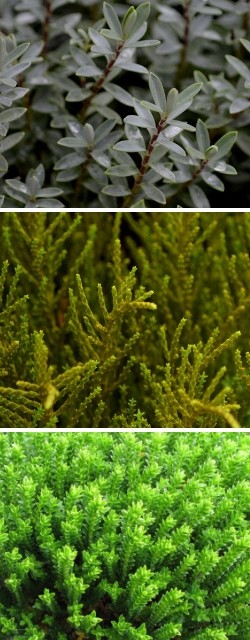
Some foliage: Hebe pimeleoides ‘Quicksilver’, Hebe ochracea, Hebe ‘Emerald Green’
1) Hebe with large leaves
They show rapid growth and produce a remarkable late flowering from July to October in large mauve, violet, blue, pink or white spikes. Leaves are more or less ovate, 5 to 10 cm long, glossy with intense colours ranging from dark green to medium green, with bronze or purple tones in winter. Lamina is marked by central vein and shows pale green shade on underside. These bushes have a rounded habit, size varying from 70 cm to 2 m in every direction, and can also be trained on stem to form a flowering ball throughout summer.
2) Hebe with small leaves
They have fairly slow growth and compact habit. Some species such as Hebe ochracea (syn. armstrongii) and Hebe cupressoides bear leaves reduced to scales reminiscent of heather or cypress, often golden-bronze, grey-green or bright green tones similar to twigs of dwarf conifers. Others produce small opposite decussate leaves recalling box, in green or silver tones and are offered as replacements for box borders weakened by various pests. Habit is globe-shaped in Green Globe or Cobb Valley, spreading in Hebe pinguifolia Sutherlandii. Shoots are sometimes brightly coloured as in Hebe pimeleoides Quicksilver, whose silvery foliage contrasts with intensely violet stems. Their delicate flowering in short spikes of white or pale pink is often quite discreet.
Veronica flower is easily recognisable by 2 prominent stamens protruding from a corolla of 4 petals fused at base, with 4 sepals and a long central pistil. Other members of family Scrophulariaceae such as foxglove (Digitalis) or mulleins (Verbascum) generally have 5 fused petals, whereas in veronicas (Veronica and Hebe) only upper petal results from fusion of two petals. In Hebe, corolla forms a rather long tube opening onto 4 lobes 2–3 mm wide. Flowers are grouped in spikes 2 to 10 cm long.
Flowers with often intense colours are very nectariferous.
Fruit is a capsule.

Some flowers: Hebe ‘Raspberry Ripple’, Hebe ochracea, Hebe ‘Ouessant’ (photo PAP), Hebe ‘Sutherlandii’
Main Varieties of Shrubby Veronicas

Hebe Wiri Charm
- Flowering time July to October
- Height at maturity 90 cm
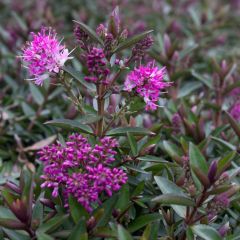
Hebe Raspberry Ripple
- Flowering time July to October
- Height at maturity 50 cm

Hebe pinguifolia Sutherlandii
- Flowering time July to September
- Height at maturity 55 cm
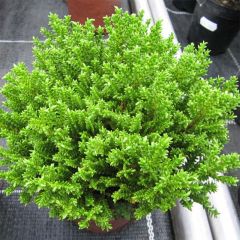
Hebe Green Globe
- Flowering time August, September
- Height at maturity 30 cm
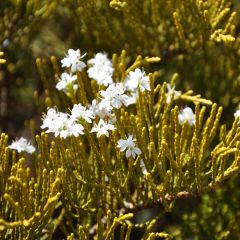
Hebe ochracea
- Flowering time July, August
- Height at maturity 60 cm

Hebe Heartbreaker
- Flowering time June to August
- Height at maturity 60 cm
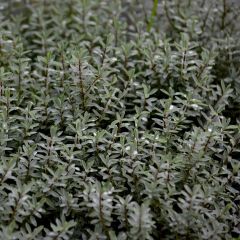
Hebe pimeleoides Quicksilver
- Flowering time July, August
- Height at maturity 45 cm
Discover other Hebe - Shrubby Veronica
View all →Available in 1 sizes
Available in 1 sizes
Available in 1 sizes
Available in 1 sizes
Available in 1 sizes
Available in 1 sizes

Available in 1 sizes
Available in 1 sizes
Available in 1 sizes
Available in 1 sizes
Planting
Where to plant shrubby veronica?
Shrubby veronicas prefer mild climates of the Atlantic or Mediterranean coast thanks also to their tolerance of sea spray, but montane species such as pinguifolia and buxifolia can withstand short frosts down to -15°C. They tolerate urban pollution fairly well, which allows attractive container displays.
They grow in any type of well-drained soil, whether neutral, slightly acidic or calcareous. Compact soil that becomes waterlogged in winter shortens their lifespan.
Large-leaved Hebe should be protected from wind to keep a dense habit while small-leaved Hebe have a habit suited to wind and drought. Provide deep, well-drained soil.
When to plant?
Container-grown plants are best planted in spring, before main summer heat, or in autumn if winters are mild.
How to plant?
This plant is easy to grow provided watering is controlled.
- Dip the rootball into a bucket of water to thoroughly wet it.
- Dig a hole three times wider than the rootball and loosen the soil around it with the tines of a digging fork.
- Add a few handfuls of sand and gravel to ensure good drainage around the roots. In heavy soil, add compost or coarse sand to lighten the structure, or opt for planting on a raised bed or in a rockery. In poor soil, add well-rotted manure or decomposed compost.
- Place the plant in the planting hole.
- Backfill with soil and firm gently.
- Water and mulch to protect against summer drought and winter frost.
For planting in a pot, choose a good potting compost for flowering plants and add a layer of clay pebbles or broken terracotta at the bottom of the container, which must have drainage holes. Avoid placing a saucer under the pot where possible.
→ Also read our care sheet : How to grow a Hebe in a pot?
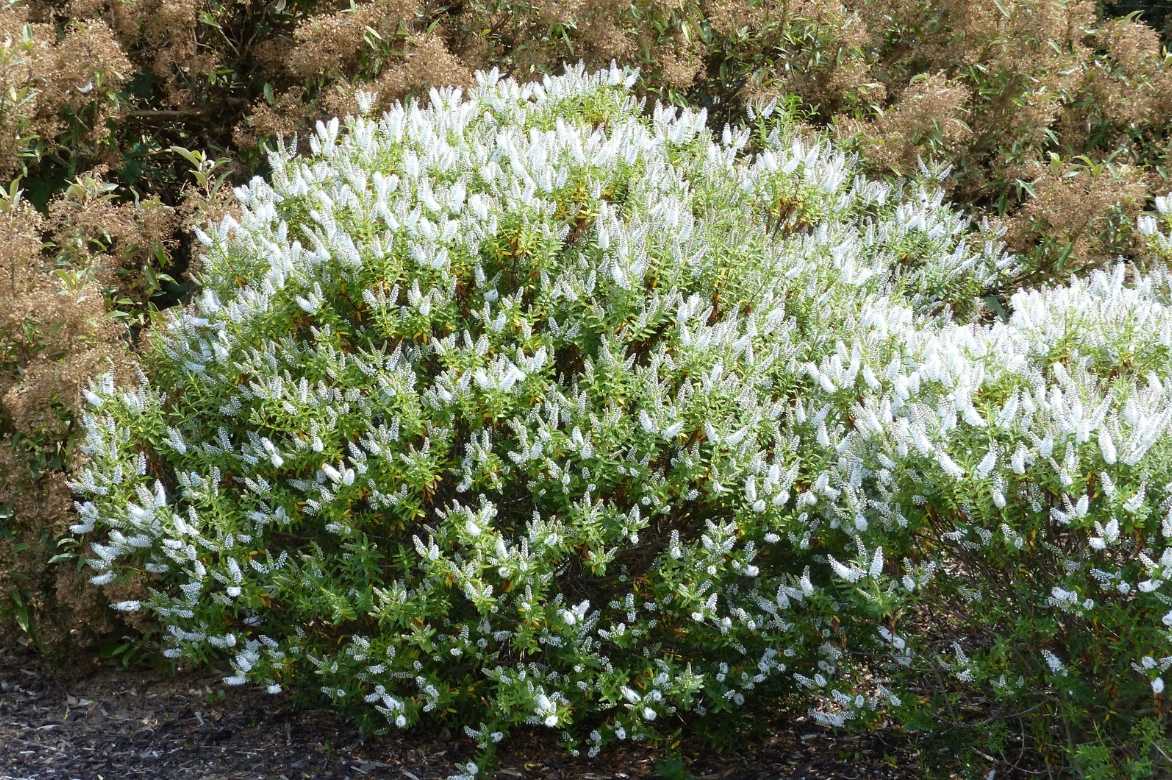
Shrubby veronica in its setting: Hebe leiophylla
Read also
Which shrubs to replace boxwood?Hebe care and pruning
Hebe can be pruned if necessary at end of winter, when growth begins to restore a compact habit and remove wood damaged by frost. This is a light pruning carried out with shears that should not remove more than two-thirds of the length of the shoots. Careful pruning of dried flowers helps keep a neat, compact appearance, especially on potted plants.
In cold regions, protect pot with bubble wrap and branches with horticultural fleece or shelter plant in a bright, cool room.
→ Find out more about veronica care in our tutorial with Ingrid: When and how to prune a shrubby veronica?
Multiplication
Simplest method of propagation is to propagate shrubby veronica by cuttings or to take layered stems from groundcover forms.
Propagation by cuttings
Prepare a deep pot by filling it with potting compost mixed with sand or with compost suitable for cuttings.
- Take in summer lignified or semi‑ripe shoots 10–15 cm long, from periphery of bush that has not borne flowers.
- Remove leaves from near base of cutting.
- Insert cuttings to two‑thirds of their length, avoiding them touching each other.
- Firm down gently all around to eliminate air pockets and ensure good contact between compost and cutting.
- Water and place them in a spot sheltered from wind and direct sunlight.
- Protect young plants under a cold frame during winter.
Rooting is quick and you can plant new young plants following spring or wait another year.
→ Find out more with our advice sheet : How to take a cutting of shrubby veronica?
Uses and companion plants
Shrubby veronicas tolerate sea spray but must not be exposed directly to sea wind. Use a low wall to plant them at the back and create a pretty flowering mound that does not rise above the top of the wall. Tall species should be reserved for less windy areas, in the background.
In a rockery, groundcover varieties can sit alongside heathers such as Erica multiflora, E. cinerea, Calluna vulgaris, Lithodora diffusa, dwarf artemisias or creeping rosemary. In coastal areas, try the false Andean heather Fabiana imbricata, flowering from May to July and suited to acidic to neutral soils, or Globularia alypum, with pretty blue heads open between January and April in calcareous soil.
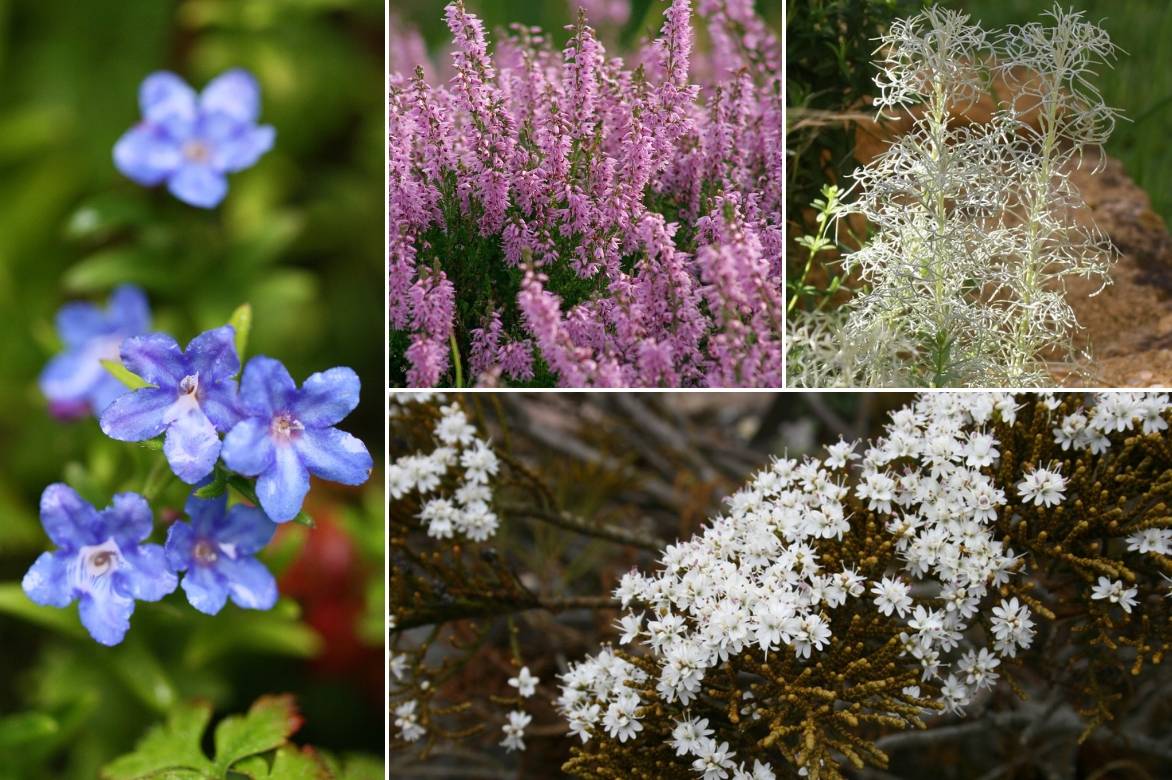
An example of a planting combination: Lithodora diffusa ‘Heavenly Blue’, Calluna vulgaris ‘H.E Beale’, Artemisia alba ‘Canescens’, Hebe ochracea
Varieties with small, graphic foliage such as Hebe Sutherlandii form attractive dense, ball-shaped specimens to display in a large pot on a stylish terrace or to structure a very sunny rockery. They make attractive, low-maintenance groundcover that hug the shape of rocks but can also be used as clipped edgings or topiaries to replace boxwood.
For more information
- Discover our range of shrubby veronicas (Hebe)
- Discover which Hebe to plant for your region?
- Our criteria for choosing a Hebe
- Our selection of 5 Hebe with variegated foliage
- Discover how to pair Hebe
- 6 Hebe with white flowers
- Our advice sheet: Hebe: best varieties for pots
- Subscribe!
- Contents
































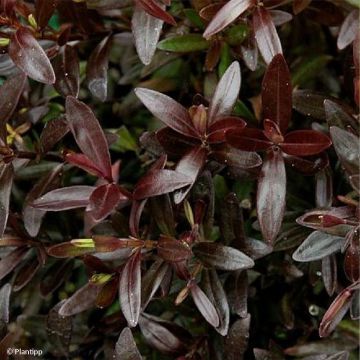

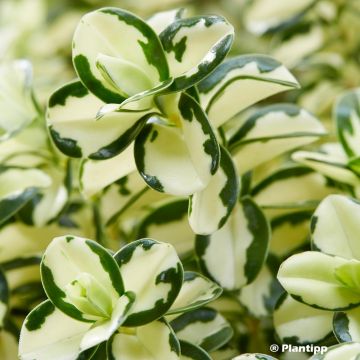
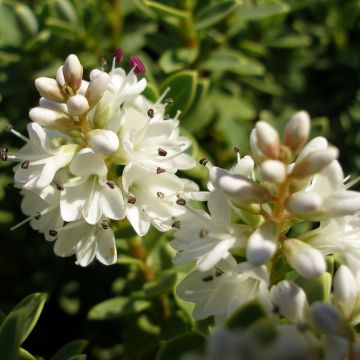
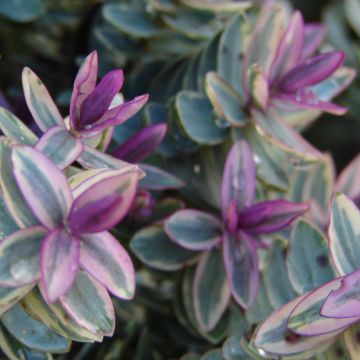
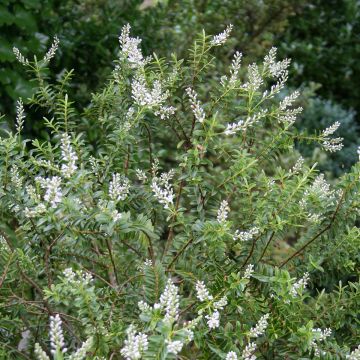
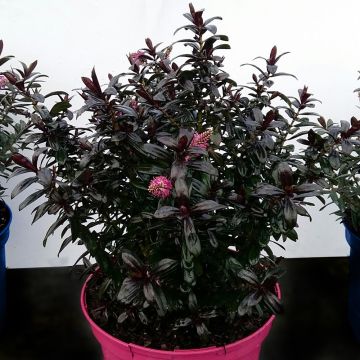

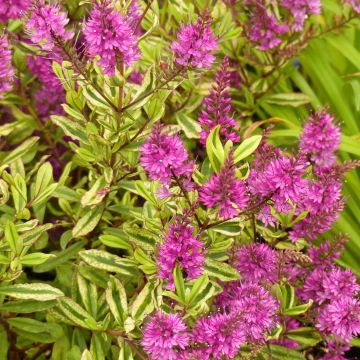
Comments